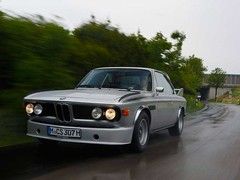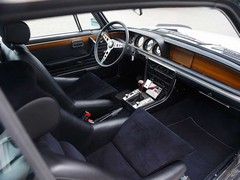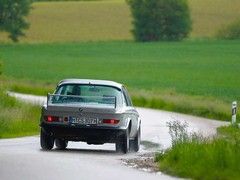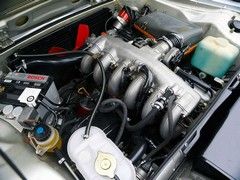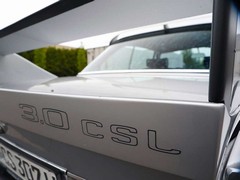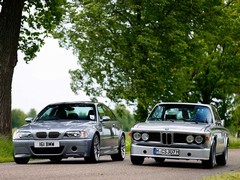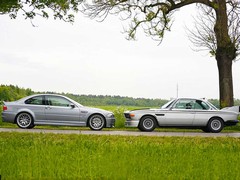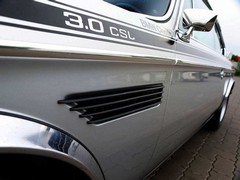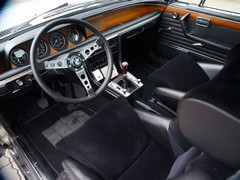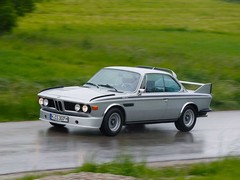Batmobile CSL meets E46 CSL
From one CSL to another - the lightweight E46 M3 CSL meets its ancestor
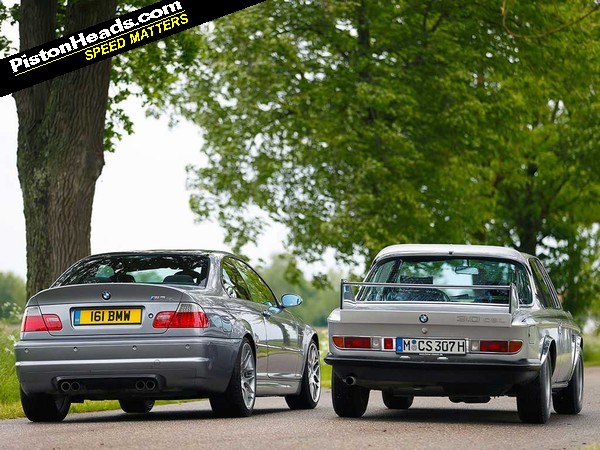
Even though PH is here as part of the E46 M3 CSL’s 10th birthday, suddenly that car seems uncharacteristically bland as you glimpse a silvery slice of iconic 70s shark nose bee-em tucked away in the corner of the workshop. This one’s in proper ‘Batmobile’ spec, a nickname the 3.0 CSL earned from its full aero package, comprising the deep front chin spoiler, the fins on the front wings, and the pair of spoilers mounted at the top of the rear window and on the boot lid.
This 3.0 CSL isn’t actually a 3.0-litre, though. Built in 1973 it’s one of the later 3.2-litre cars running Bosch fuel injection, of which just 167 were made. That means, when new, it was pushing out a healthy 206hp at 5,500rpm, would reach 62mph from rest in seven seconds flat and would go on to a top speed of 137mph. It still feels strong today.
Leaner, meaner
That’s because it’s light. It weighs just 1,163kg – up to 250kg less than the regular E9 coupe it was based on if the ‘city package’ geared for comfort was deleted. The CSL used lighter alloy panels for the bonnet, boot and door skins, as well as thinner gauge steel for the front wings and lighter glass. Add to that the pared back interior through the removal of superfluous soundproofing and trim and you had a featherweight performance car by contemporary standards.
You might expect a 40-year-old car to feel a bit on the baggy side, but having just topped 42,000km, the CSL feels tight and mechanically fresh. The four-speed ‘box is positive to engage and the steering, although slow, elicits the slightest of reactions from the front wheels with even a tiny touch of lock – compared to controversial electric power steering, this is full analogue in a modern digital world. With 25 per cent locking effect on the diff, old school tech tyres and wet country roads it made things interesting, too. I’ll admit, I’ve not had much exposure to cars of this ilk and there’s definitely a certain way to drive them – you’ve got to commit to the throttle to get the nose pointing where you want it, using the gas to steer the car through the corner.
A slow rack and little grip makes it interesting when an irreplaceable classic costing 75,000 euros first breaks away on you, but the clarity with which the messages are relayed from every interface can’t fail to inspire confidence. The throttle’s weight is heavy, but the pedal’s responsive, and in no time you find yourself pumping the accelerator to trim your line and test for grip.
You’ve got to work the feel-rich, unassisted steering quite hard to make the car change direction, but when you do it’s surprising how agile the CSL is – the lightweight parts making themselves known by a distinct lack of inertia – and just how the culling of mass released a stiff, but supple and compliant chassis surprisingly resistant to roll.
The brakes require a good prod to haul the car down owing to the absence of servo assistance, but unsurprisingly, due to the lack of mass to slow, the retardation levels are impressive. The massive weight saving over the standard E9 coupe improved the CSL in every respect.
Blood brothers
Despite the 30-year age difference, it’s surprising how many parallels there are between the E9 and the E46 CSLs. There are the obvious links in that both cars had a serious amount of weight removed from the standard production vehicles, boasting lightweight body panels in places and an interior by Weight Watchers, but there are more similarities when it comes to the mechanicals. Three decades of development might mean the E46 revs harder and faster, but the nature of the full, round sound that infects your brain in the mid-range, overlaid with a hard-edged metallic rasp, is uncanny. The E9 sings, and at 2,800rpm the resonance inside the cabin is colossal.
As you as you drop your hips into the slim seat in both vehicles, you feel wired into the respective machines. The proportions feel remarkably similar too, as does the quality of the sensations relayed back to the driver. You have to command the car and be positive with your inputs to tell it where to go and how fast to do it. You feel like the front axle in both lightweight specials is keen for action and boasts the talent to back it up, while the rear end has strong traction to balance the front, but can be made mobile on request.
CSL and the future
Although everything happens at a lower speed in the original 3.0, you have to be accurate to drive it quickly, just like in the E46. The engine’s urgency from the punchy mid-range will trouble the rear tyres on anything other than a bone dry surface and it means you have to be on your game with winding on corrective lock. Catch the narrow A-pillars out of the corner of your eye when you’re doing it and the lack of safety features certainly focuses the mind. It doesn’t suffer fools gladly, and although the transmission is still slick, particularly on up changes, if you don’t blip the throttle quite enough on the way down it’ll resist your efforts with a recalcitrant streak – not such a problem you’re faced with in the newer car.
Everything you feel in the 3.0 CSL reflects its lightweight concept. With the drive for efficiency in the modern era, especially in performance cars, this philosophy of a lack of mass is once again relevant. Along with the most recent CSL, this is BMW at its very best. An M4 CSL next? Let’s hope so.
BMW 3.0 CSL (1973)
Engine: 3,153cc 6-cyl, fuel-injection
Transmission: 4-speed manual, rear-wheel drive
Power (hp): 206@5,600rpm
Torque (lb ft): 212@4,200rpm
0-62mph: 7.0 sec
Top speed: 137mph
Weight: 1,163kg
MPG: n/a
CO2: n/a
Price: 37,580 German Marks in 1973
Gassing Station | General Gassing | Top of Page | What's New | My Stuff

